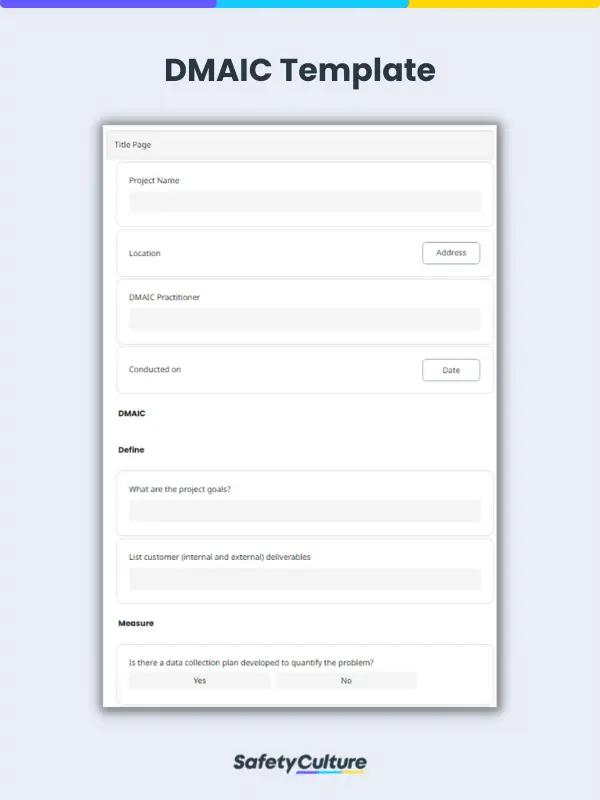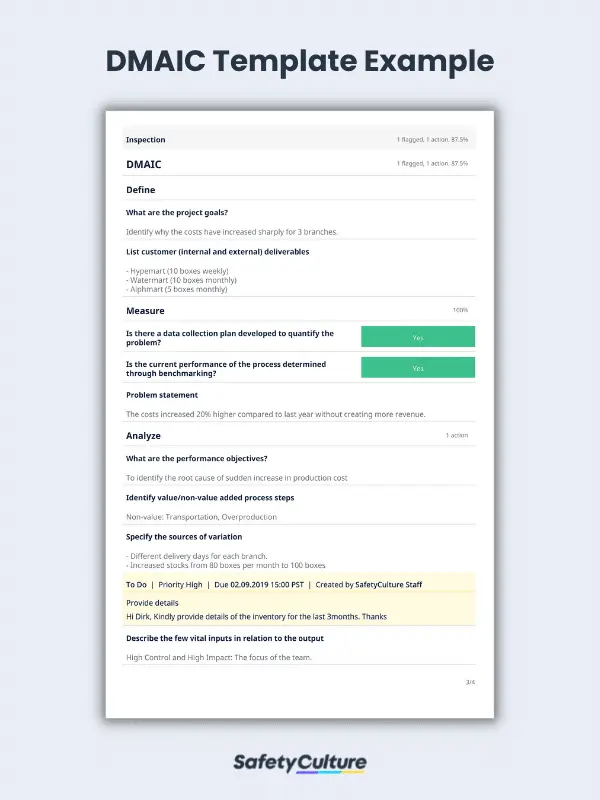What is a DMAIC Template?
A DMAIC (Define-Measure-Analyze-Improve-Control) template is a tool used to systematically tackle deficiencies in existing practices and strategize process improvement initiatives. It follows the five-step structure of the DMAIC method as a best practice for Six Sigma practitioners. This document is ideal for enhancing underperforming products, services, and systems in sectors such as manufacturing and healthcare.
Benefits
The DMAIC method takes a data-driven angle to process and product improvement. Using a systematic approach, they can implement targeted solutions for resolving issues down to their roots. However, drafting DMAIC reports from scratch can take time to complete.
Enter the DMAIC template, a more streamlined route to carrying out the DMAIC method. Having a ready-made template allows Six Sigma practitioners to gather data in an efficient manner, as they only need to fill out the form in the order it’s structured. They no longer need to create reports from the beginning, for they can save this template on their device for future use.
By simplifying the paperwork side of things using a DMAIC template, Six Sigma professionals can focus their efforts on applying DMAIC effectively.
Components
The DMAIC template consists of five components representing the phases of the DMAIC model: Define, Measure, Analyze, Improve, and Control. This section explores each of these phases as follows:
Define
The first element in a DMAIC template calls for the project goals. In this section, you must specify the primary objective or problem of the DMAIC study in detail. Here are some guide questions to help you answer this portion effectively.
- What goal are you aiming to achieve? / What issue are you trying to address?
- Why is it important?
- What are its corresponding customer deliverables (both internal and external)?
Measure
After determining the main goal or issue, it’s also essential to include quantifiable metrics in obtaining the data you need. Consider the following guide questions when establishing benchmarks for your DMAIC report:
- Is there a data collection plan for quantifying the problem?
- Is the current performance of the process determined through measurable targets?
- On what basis can you determine if the data collection plan is successful?
- What outcomes are you looking for in the process?
Analyze
The analysis component adds another layer to your DMAIC process template. In this portion, you will investigate the roots of the problem and categorize possible causes or key processes into different priority levels.
A sound DMAIC analysis follows the set of questions listed below:
- What are the performance objectives?
- What are the steps that add or provide no value to the process?
- Why did the issue happen?
- How does it impact the process outcomes?
- What are the primary root causes of the problem?
Improve
This component explains the possible courses of action to enhance underperforming processes or products. In this part, you will implement potential solutions based on the data you’ve gathered and analyzed in the previous section.
The following guide questions will steer you in the right direction while testing and setting out improvement measures:
- What solutions can you implement to resolve the issue?
- Are operating tolerances of the potential system well-defined?
- Were design experiments performed?
- Were potential improvements validated through pilot studies?
- Were potential solutions assessed and re-evaluated?
Control
The DMAIC process doesn’t end after selecting the most viable solution for the goal or issue. There must also be a system to keep track of and maintain these enhanced processes in the long run. Here are some questions to guide you in monitoring your improvement initiatives:
- What is the monitoring and control system in place?
- Was the statistical process control applied?
- How will the handoff to the process owner proceed?
- Were benefits, cost savings/avoidance, and profit growth verified?
Example of a DMAIC Template
The image below illustrates how a DMAIC template works as a data-driven process improvement tool.
In this example, the company investigates the reason for the increasing costs in three of its branches. Through this template, they can map out the problem, determine its root cause, and implement solutions to reduce their expenses.
FAQs about DMAIC Templates
Yes, the DMAIC process is primarily used for enhancing systems and practices under the Six Sigma framework. However, you can also use this tool on its own or with other process improvement methodologies like Lean.
Organizations implementing the Six Sigma methodology can benefit from using a DMAIC template. This tool is especially helpful for industries requiring consistent and high-quality results, such as manufacturing, healthcare, construction, education, and professional services.
- Define the project goals and list their expected outputs.
- Lay down quantifiable benchmarks for data collection.
- Write down the possible root causes of the problem.
- List feasible solutions and note your observations during the testing stage.
- Verify the results of the test and monitor its effectiveness.
- Provide additional remarks not included in any of the previous sections.
- Affix your name and signature as proof of completion.




